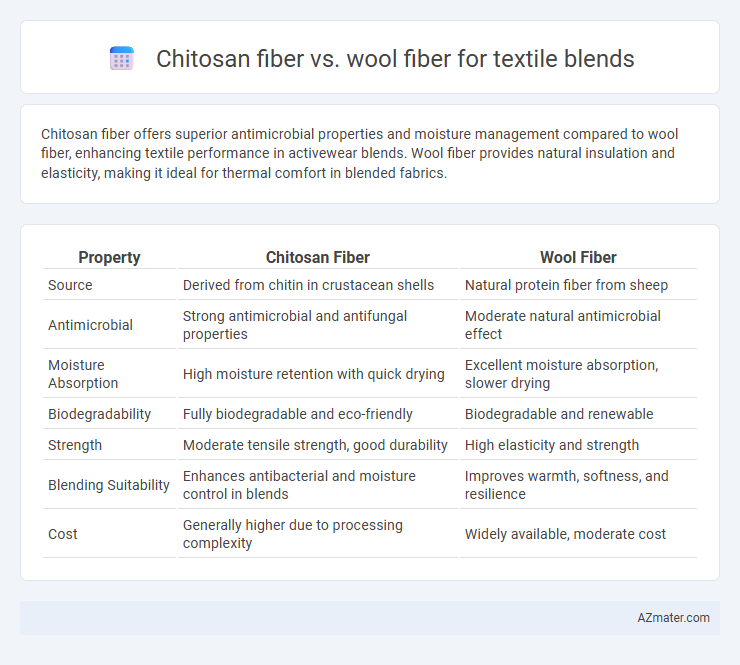Chitosan fiber offers superior antimicrobial properties and moisture management compared to wool fiber, enhancing textile performance in activewear blends. Wool fiber provides natural insulation and elasticity, making it ideal for thermal comfort in blended fabrics.
Table of Comparison
| Property | Chitosan Fiber | Wool Fiber |
|---|---|---|
| Source | Derived from chitin in crustacean shells | Natural protein fiber from sheep |
| Antimicrobial | Strong antimicrobial and antifungal properties | Moderate natural antimicrobial effect |
| Moisture Absorption | High moisture retention with quick drying | Excellent moisture absorption, slower drying |
| Biodegradability | Fully biodegradable and eco-friendly | Biodegradable and renewable |
| Strength | Moderate tensile strength, good durability | High elasticity and strength |
| Blending Suitability | Enhances antibacterial and moisture control in blends | Improves warmth, softness, and resilience |
| Cost | Generally higher due to processing complexity | Widely available, moderate cost |
Introduction to Chitosan and Wool Fibers
Chitosan fiber, derived from chitin found in crustacean shells, offers exceptional antimicrobial properties, biodegradability, and moisture management, making it a sustainable alternative in textile blends. Wool fiber, obtained from sheep fleece, is renowned for its natural insulation, elasticity, and moisture-wicking capabilities, enhancing warmth and comfort in fabrics. Combining chitosan with wool fibers in textile blends improves durability, odor resistance, and environmental sustainability, meeting both performance and eco-friendly demands in modern textiles.
Source and Sustainability Comparison
Chitosan fiber, derived from the exoskeletons of crustaceans like shrimp and crabs, offers a renewable and biodegradable alternative to traditional wool fibers sourced from sheep. Wool production involves extensive land and water use, along with methane emissions, whereas chitosan fiber leverages seafood industry waste, reducing environmental impact. The sustainability of chitosan fiber is enhanced by its biodegradability and lower carbon footprint, making it a compelling choice for eco-friendly textile blends.
Fiber Structure and Morphology
Chitosan fiber exhibits a smooth, homogeneous surface with excellent biocompatibility and antimicrobial properties, while wool fiber features a scaly surface structure that enhances felting and moisture absorption. The amorphous regions in chitosan fibers allow for better chemical modification and dye uptake, contrasting with the crystalline keratin structure of wool that provides elasticity and warmth. Blending chitosan with wool fibers optimizes fabric performance by combining chitosan's strength and biodegradability with wool's natural insulation and resilience.
Mechanical Properties and Strength
Chitosan fiber exhibits superior tensile strength and enhanced elasticity compared to wool fiber, making it a durable choice for textile blends. The mechanical properties of chitosan fiber, such as higher modulus and abrasion resistance, contribute to increased fabric longevity and resilience. Wool fiber offers excellent natural crimp and softness but has lower tensile strength and is more prone to mechanical damage in blended textiles.
Moisture Absorption and Comfort
Chitosan fiber exhibits superior moisture absorption compared to wool fiber, due to its hydrophilic nature and unique molecular structure that effectively wick sweat away from the skin. Wool fiber, while naturally breathable, retains moisture for longer periods, which can reduce overall comfort in humid conditions. Blending chitosan with wool enhances the textile's ability to manage moisture, resulting in increased comfort and dryness for the wearer.
Antimicrobial and Allergenic Properties
Chitosan fiber exhibits strong antimicrobial properties due to its natural polymer structure derived from chitin, effectively inhibiting bacterial growth and odor in textile blends. Wool fiber, while offering moderate antimicrobial benefits through lanolin content, is more prone to causing allergic reactions in sensitive individuals due to its protein composition. Combining chitosan with wool fiber in textile blends enhances antimicrobial performance and reduces allergenicity, making the fabric suitable for sensitive skin and hygienic applications.
Dyeability and Color Retention
Chitosan fiber exhibits superior dyeability compared to wool fiber due to its abundant amino groups, which form strong chemical bonds with dyes, resulting in more vibrant and uniform coloration. Wool fiber, while naturally possessing good dye affinity because of its protein structure, often shows less consistent dye uptake and can fade faster under prolonged exposure to light and washing. In textile blends, incorporating chitosan fiber enhances color retention and wash-fastness, making it ideal for achieving long-lasting and vivid hues.
Thermal Insulation Performance
Chitosan fiber exhibits superior thermal insulation performance compared to wool fiber due to its unique molecular structure that enhances moisture management and heat retention. The hydrophilic properties of chitosan fiber allow efficient vapor absorption and release, maintaining a comfortable microclimate close to the skin. Wool fiber offers good insulation through its natural crimp and air-trapping capability but may underperform in moisture regulation relative to chitosan blends in textile applications.
Environmental and Biodegradability Aspects
Chitosan fiber, derived from crustacean shells, offers superior biodegradability and environmental benefits compared to traditional wool fiber, which is animal-based and takes longer to decompose. Chitosan fibers contribute to sustainable textile blends by reducing waste through their natural antimicrobial properties and faster degradation rates in composting conditions. Wool fiber, while renewable, involves intensive resource use and slower biodegradation, leading to higher environmental impact in large-scale textile production.
Applications in Textile Blends and Future Prospects
Chitosan fiber offers superior antimicrobial properties and moisture management, making it ideal for activewear and medical textiles when blended with wool fibers known for their warmth and elasticity. This blend enhances durability, comfort, and odor control, expanding applications in eco-friendly fashion and performance textiles. Future prospects include the development of biodegradable and sustainable textile composites that leverage chitosan's bioactivity with wool's natural insulation.

Infographic: Chitosan fiber vs Wool fiber for Textile blend
 azmater.com
azmater.com